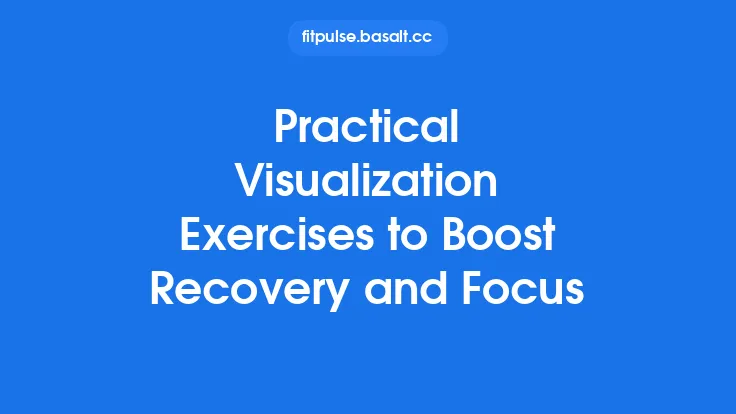Neuroplasticity—the brain’s remarkable capacity to reorganize its structure, function, and connections in response to experience—lies at the heart of both physical and mental recovery. While the term often conjures images of learning a new language or mastering a musical instrument, its principles apply equally to healing after injury, managing chronic stress, and restoring optimal cognitive performance. By understanding the underlying mechanisms and applying evidence‑based strategies, athletes, clinicians, and anyone seeking resilient recovery can deliberately “coach” their brains toward faster, more complete healing.
The Foundations of Neuroplasticity
Synaptic Plasticity and Long‑Term Potentiation
At the cellular level, neuroplasticity is driven by changes in synaptic strength. When neurons fire together repeatedly, the synapse between them becomes more efficient—a process known as long‑term potentiation (LTP). LTP underlies learning and memory formation, and it also supports the brain’s ability to compensate for damaged pathways after injury.
Structural Remodeling: Dendritic Growth and Axonal Sprouting
Beyond synaptic adjustments, neurons can physically remodel themselves. Dendritic spines—tiny protrusions that receive input—can proliferate in response to enriched environments or targeted training. Similarly, axons may sprout new branches to bypass lesions, establishing alternative routes for signal transmission.
Neurogenesis in the Adult Brain
Although once thought to be limited to early development, the generation of new neurons (neurogenesis) persists in specific regions such as the hippocampus and subventricular zone. These newborn cells contribute to pattern separation, mood regulation, and the integration of new motor skills, all of which are relevant to recovery.
How Neuroplasticity Supports Physical Recovery
Re‑Establishing Motor Maps After Musculoskeletal Injury
When a joint is immobilized or a muscle is weakened, the cortical representation of that body part shrinks—a phenomenon known as “use‑dependent cortical depression.” Targeted rehabilitation exercises stimulate the corresponding motor cortex, encouraging re‑expansion of the motor map and restoring fine‑grained control.
Central Sensitization and Pain Modulation
Chronic pain often reflects maladaptive plasticity within the dorsal horn of the spinal cord and higher pain‑processing centers. Graded exposure to movement, combined with sensory discrimination training, can “de‑sensitize” these circuits, reducing pain perception and facilitating functional return.
Cross‑Education Effects
Training the uninjured limb can induce bilateral neuroplastic changes, a principle called cross‑education. This effect can preserve strength and neural drive in the injured limb during periods of immobilization, shortening the overall rehabilitation timeline.
Neuroplasticity in Mental Recovery and Stress Resilience
Rewiring Stress‑Responsive Networks
Prolonged stress reshapes the amygdala‑prefrontal circuitry, heightening threat detection while dampening executive regulation. Structured exposure to manageable stressors—such as progressive cognitive challenges—promotes adaptive remodeling, strengthening prefrontal inhibition over the amygdala and fostering emotional stability.
Cognitive Flexibility Through Executive Training
Tasks that require set‑shifting, working‑memory updating, and inhibitory control (e.g., dual‑n‑back, task‑switching paradigms) enhance the dorsolateral prefrontal cortex’s capacity to orchestrate flexible responses. Improved cognitive flexibility translates to better coping strategies when faced with training setbacks or competition pressure.
Memory Reconsolidation for Traumatic Experiences
When a memory is reactivated, it briefly becomes labile, allowing for modification before reconsolidation. Therapeutic protocols that pair memory reactivation with novel, non‑threatening information can attenuate the emotional intensity of past injuries or performance‑related traumas, supporting mental recovery without reliance on traditional exposure therapy.
Evidence‑Based Interventions to Promote Adaptive Plasticity
Aerobic Conditioning as a Neuroplastic Primer
Regular moderate‑intensity aerobic exercise elevates brain‑derived neurotrophic factor (BDNF), insulin‑like growth factor‑1 (IGF‑1), and vascular endothelial growth factor (VEGF). These molecules facilitate synaptogenesis, dendritic branching, and angiogenesis, creating a fertile environment for subsequent skill acquisition or rehabilitation.
Skill‑Specific Motor Learning Protocols
- Variable Practice: Alternating between different movement patterns or speeds forces the brain to encode a more generalized motor schema, enhancing transfer to novel contexts.
- Error‑Augmented Feedback: Amplifying perceived errors (e.g., via visual distortion) accelerates error detection mechanisms, prompting quicker corrective adaptations.
- Distributed Practice: Short, frequent training bouts spaced over time outperform massed sessions in consolidating long‑term motor memory.
Sensory Enrichment and Multimodal Stimulation
Combining tactile, proprioceptive, and visual inputs during rehabilitation (e.g., using textured surfaces, mirror therapy, or virtual reality) maximizes cortical activation, encouraging richer synaptic networks that support functional recovery.
Neuromodulation Techniques
- Transcranial Direct Current Stimulation (tDCS): Low‑intensity currents applied over motor or prefrontal cortices can boost excitability, facilitating learning when paired with task practice.
- Repetitive Transcranial Magnetic Stimulation (rTMS): Targeted high‑frequency pulses can up‑regulate underactive regions (e.g., the dorsolateral prefrontal cortex) implicated in stress regulation and executive control.
Neurofeedback for Self‑Regulation
Real‑time EEG or fNIRS feedback enables individuals to consciously modulate specific brain rhythms associated with attention, relaxation, or motor preparation. Consistent neurofeedback training has been shown to increase alpha power and improve autonomic balance, supporting both mental calmness and motor precision.
Lifestyle Pillars That Amplify Plasticity
Nutrition: Fuel for Synaptic Growth
- Omega‑3 Fatty Acids: DHA incorporates into neuronal membranes, enhancing fluidity and receptor function.
- Polyphenols (e.g., curcumin, resveratrol): Antioxidant properties protect against oxidative stress, preserving neurogenesis.
- Complex Carbohydrates: Steady glucose supply sustains ATP production necessary for synaptic remodeling.
Sleep Architecture and Memory Consolidation
Slow‑wave sleep (SWS) and rapid eye movement (REM) sleep each play distinct roles in consolidating procedural and declarative memories, respectively. Optimizing sleep hygiene—consistent bedtime, dark environment, limited blue‑light exposure—ensures the brain can replay and strengthen newly formed neural patterns.
Hormonal Balance
Chronic elevations in cortisol impair LTP and neurogenesis, whereas balanced levels of testosterone and estrogen have neuroprotective effects. Strategies that naturally modulate endocrine function (e.g., regular physical activity, stress‑reduction practices not covered elsewhere) complement neuroplastic interventions.
Harnessing Technology to Accelerate Brain‑Based Recovery
Virtual Reality (VR) for Immersive Motor Re‑training
VR environments provide controlled, repeatable scenarios that can be progressively intensified. By coupling visual flow with proprioceptive cues, VR stimulates multisensory integration, a key driver of cortical reorganization.
Wearable Sensors and Closed‑Loop Feedback
Inertial measurement units (IMUs) and electromyography (EMG) sensors capture real‑time movement quality. Algorithms can adjust task difficulty on the fly, ensuring the brain receives an optimal “challenge‑to‑skill” ratio that maximizes plastic change.
Mobile Cognitive Training Apps
Evidence‑based platforms that adapt difficulty based on performance metrics (e.g., reaction time, accuracy) keep the prefrontal cortex engaged, fostering executive resilience that translates to better stress coping during training cycles.
Designing a Personal Neuroplasticity Plan
- Assessment Phase
- Conduct baseline neurocognitive testing (working memory, processing speed) and motor function evaluation.
- Identify stress‑sensitive circuits via questionnaires or physiological markers (heart‑rate variability).
- Goal Specification
- Define concrete, measurable outcomes (e.g., “increase dorsiflexion strength by 15 % in 6 weeks” or “reduce perceived stress score by 20 %”).
- Intervention Matrix
- Aerobic Component: 30 min of moderate‑intensity cardio, 3–4 times/week.
- Skill‑Specific Training: 2–3 sessions/week of variable, error‑augmented motor drills.
- Cognitive Challenge: 15 min daily of adaptive working‑memory tasks.
- Neuromodulation (if accessible): tDCS paired with the primary skill session, 20 min at 1–2 mA.
- Lifestyle Integration: Prioritize 7–9 hours of sleep, omega‑3‑rich meals, and hydration.
- Progress Monitoring
- Weekly performance logs, monthly neurocognitive reassessments, and periodic physiological checks (HRV, resting cortisol).
- Iterative Adjustment
- Increase task difficulty when success rates exceed 80 %; introduce novel sensory contexts if plateaus emerge.
Measuring Success: Objective and Subjective Indicators
- Neurophysiological Metrics: Increases in motor‑evoked potential amplitude, enhanced BDNF serum levels, or normalized EEG alpha/theta ratios.
- Functional Outcomes: Faster return‑to‑play timelines, reduced injury recurrence, improved balance or agility scores.
- Psychological Benchmarks: Lower scores on validated stress inventories, higher resilience indices, and self‑reported confidence in coping with training demands.
Future Directions in Neuroplasticity‑Driven Recovery
Research is rapidly converging on multimodal protocols that blend biological, technological, and behavioral elements. Emerging areas include:
- Gene‑Environment Interactions: Understanding how individual genetic profiles (e.g., BDNF Val66Met polymorphism) influence responsiveness to plasticity‑enhancing interventions.
- Personalized Neuromodulation: Adaptive algorithms that tailor stimulation parameters in real time based on EEG feedback.
- Microbiome‑Brain Axis: Investigating how gut flora modulates neuroinflammation and, consequently, plastic potential during recovery.
As the science evolves, the core principle remains unchanged: the brain is not a static organ but a dynamic system that can be guided, nurtured, and reshaped. By deliberately applying neuroplasticity‑focused strategies, athletes, clinicians, and everyday individuals can transform recovery from a passive waiting period into an active, empowering process.





